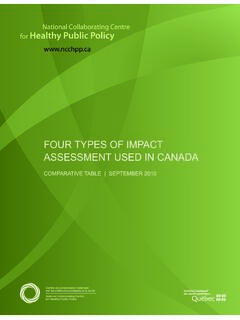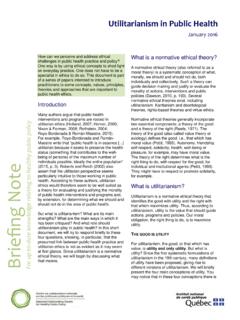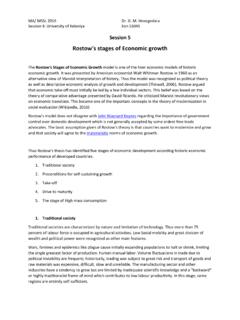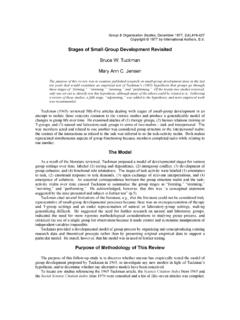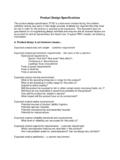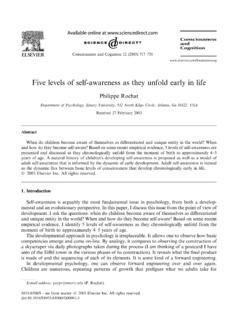Transcription of Public Policy Models and Their Usefulness in Public Health ...
1 Briefing NoteFor up-to-date knowledge relating to healthy Public policyPublic Policy Models and Their Usefulness in Public Health : The Stages model October 2013 This briefing note belongs to a series on the various Models used in political science to represent Public Policy development processes. Each of these briefing notes begins by describing the analytical framework proposed by a given model . Then we set out to examine questions that Public Health actors may ask regarding Public Policy , while keeping in mind the perspective that this model affords. It should be noted that our aim in these notes is not to further refine existing Models ; nor is it to advocate for the adoption of one of them in particular. Our purpose is rather to suggest how each of these Models constitutes a useful interpretive lens that can guide reflection and action leading to the production of healthy Public policies. The stages model provides a good illustration of the Usefulness of analytical frameworks for examining Public policies.
2 This model makes it possible to present the complex process of Public Policy development in a relatively simple manner, which explains its popularity both among undergraduate students learning about Public Policy as well as among Public Health actors seeking an analytical tool that can be applied to Public Policy processes. The stages model is referred to in a number of ways and has been variously called the linear model , the sequential model , the heuristic stages model or the Public Policy cycle (see, for example, Anderson, 2011; Smith & Larimer, 2009; Lemieux, 2002; DeLeon, 1999; Jones, 1997; Brewer & DeLeon, 1983). In this note, we present a five - stage model , which represents a synthesis of these approaches (Howlett & Ramesh, 2003). Description of the model According to this model , the process of producing Public policies can be divided into several stages. Although initial versions of this model created the impression that these stages occurred successively and that Policy development was a linear process, it is now understood that these stages sometimes occur simultaneously, sometimes appear in inverse order and are sometimes rapidly skirted.
3 In fact, each of these stages corresponds to several moments in the life of a Policy , which are related to specific activities associated with the Policy , but the stages very rarely follow one another in a linear progression. Various authors have developed stages Models , with the number of stages varying between five and seven. Howlett and Ramesh s model identifies five stages: agenda setting, Policy formulation, adoption (or decision making), implementation and evaluation. Let us briefly examine each of these stages. AGENDA SETTING This stage refers to the process through which a Policy and the problem it is intended to address are acknowledged to be of Public interest. Some authors differentiate among several types of agendas, including discussion agendas and decision agendas. The discussion agenda, or Public agenda, includes issues that have become highly visible and have thus become the subject of discussion. The decision agenda, or formal agenda, includes the list of issues the government has decided to address (Cobb & Elder, 1972).
4 For a Policy to be placed on the agenda, there seem to be certain prerequisites. Individuals or groups must acknowledge that a situation is problematic, identify the problematic aspects of the situation, propose solutions, and engage in activities that influence the government and pressure it to intervene, including identifying groups that can play an active role in addressing the problem (Ripley, 1985, in McCool, 1995, p. 159). A wide range of literature covers this stage and examines the strategies that groups of actors use to get a Policy placed on the government s 1 We will be publishing another briefing note devoted entirely to this topic. Tel: 514 864-1600 ext. 3615 Email: Twitter: @NCCHPP Briefing Note Public Policy Models and Their Usefulness in Public Health : The Stages model Adoption Agenda setting Policy Formulation Implementation Evaluation Policy FORMULATION At this stage , the Public administration concerned examines the various Policy options it considers to be possible solutions.
5 It should be noted that coalitions of actors strive, through the use of advocacy strategies, to gain priority for one specific interpretation of both the problem and its solution. It is at this stage that power relationships crystallize, determining the direction a Policy will take. ADOPTION (OR DECISION MAKING) Adoption is the stage during which decisions are made at the governmental level, resulting in a decision that favours one or more approaches to addressing a given problem. IMPLEMENTATION At this stage , the Policy s implementation parameters are established, which can directly affect the eventual outcome of the Policy . Several factors combine to determine the actual effects of a Policy and how well it achieves its objectives. Factors noted by Sabatier and Mazmanian include: The type and complexity of the problem addressed, The magnitude of the expected change and the groups targeted by the Policy , The human and financial resources devoted to implementation, and The administrative structures and regulations that will be put in place to support implementation of the Policy (Sabatier & Mazmanian, 1995).
6 Note that high demands are placed on the technical-administrative apparatus at this stage , and on groups associated with this Policy sector. The term Policy network is often used to refer to the actors within the government, as well as the stakeholders associated with a Policy sector, who are in a sense experts in the area. This Policy network will have a major influence on how the Policy is implemented. Figure 1 Stages in policymaking: a turbulent flow Tel: 514 864-1600 ext. 3615 Email: Twitter: @NCCHPP Note 3 Public Policy Models and Their Usefulness in Public Health : The Stages model EVALUATION This is the stage during which a Policy is evaluated, to verify whether its implementation and its effects are aligned with the objectives that were explicitly or implicitly set out. This evaluation can be carried out by the government apparatus, by consultants or by civil society (Howlett & Ramesh, 2003). How can this model guide Public Health actors? THIS model CAN HELP TO SITUATE THE CONTEXT AND THE CHANNELS OF INFLUENCE The stages model separates out the different activities associated with a Public Policy .
7 For Public Health actors who wish to take part in the production of Public policies, this model provides a framework for reflecting on the processes surrounding development of a Public Policy . With the help of the benchmarks identified in the stages model , Public Health actors can reflect on relevant questions and identify the players involved with a Public problem at different stages, as well the opportunities for intervention, which constitute so many entry points into the Policy development process. Using the segmentation of the Policy process proposed by the stages model , we propose questions to ask at each stage . The questions are prompted by the literature on political science and are relevant to this and to other Models . This list, found in Appendix A, is not exhaustive and may be supplemented by other questions. As mentioned above, Public Policy development is not a linear process. Indeed, many of the stages in this process frequently overlap. Although we have classified the questions according to the different stages in the model , it should be noted that the questions proposed for a specific stage can be just as relevant at other stages.
8 It should also be noted that the role of societal actors is not limited, as is sometimes indicated, to simply influencing government agenda setting. Power relationships between different social groups and stakeholders, both outside and within the government apparatus, can interact at all stages of the process. The same applies to the influence of these groups. IT CAN HELP TO DETERMINE WHAT TYPE OF INFORMATION IS REQUIRED BY DECISION MAKERS Since each of these stages identifies specific moments in the Policy development process, they represent so many opportunities for introducing information produced or provided by Public Health actors. It should be noted here that information requirements differ at each of these stages. By reflecting on the stage at which they are intervening, Public Health actors can better determine the purpose and the type of information required. They can also determine whether the problem is viewed as a technical one, in which case Their expertise will be actively sought (Fafard, 2008, p.)
9 17; Baumgartner & Jones, 1991, p. 1047). When the problem is more controversial and ethically, socially or politically divergent points of view are at play, the contribution of other actors tends to predominate, although the contribution of experts, in Public Health or in other areas, remains useful. Let us take the example of agenda setting. For an issue to be included on the decision agenda, the situation must be perceived as problematic. Public Health actors can assume, therefore, that the information required at this stage should focus on the significance of a problem and its impact on Public Health . It is also at this stage that causal agents are identified; that is, the relationship between a phenomenon and its determinants. This last step, which justifies government intervention, does not always immediately follow the discovery of epidemiological links. To use a well-known Public Health example, the association between smoking and Health problems had, in fact, been established long before the appearance of tobacco control policies (Cunningham, 1996; National Collaborating Centre for Healthy Public Policy , 2008).
10 How then can an issue be moved from the discussion agenda to the decision agenda? According to Deborah Stone, it is the causal stories presented by stakeholders that guide debate and prompt government intervention (Stone, 1989). Causal stories guide our perception of a problem, its causes and who bears responsibility. They are directly related to how we choose to respond or not to respond to a situation. As Scheberle points out, with reference to policies on radon, scientific knowledge about Health impacts is not sufficient to initiate the process of Public Policy development. It is also necessary for groups of actors to demonstrate the need for government intervention, and to identify Tel: 514 864-1600 ext. 3615 Email: Twitter: @NCCHPP Briefing Note Public Policy Models and Their Usefulness in Public Health : The Stages model those responsible; in short, they must produce causal stories (Scheberle, 1994). However, in the case of radon, a gas produced naturally by uranium, the two most politically active groups in the area of radiation and its effects (the pro-nuclear and energy-conservation groups) had, for opposing reasons, little interest in focusing the attention of legislators on the negative effects of radon.





